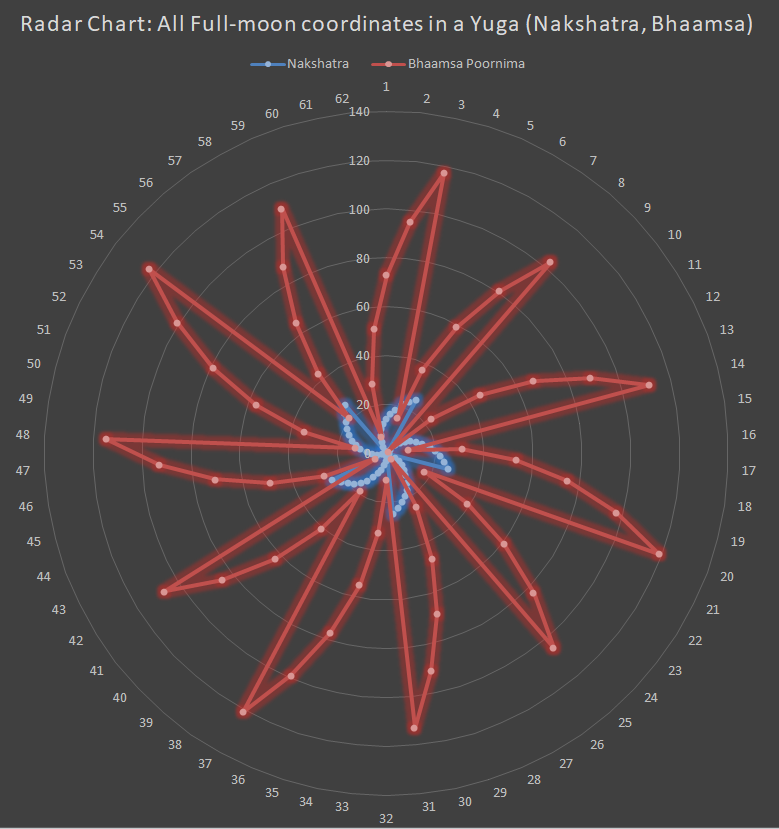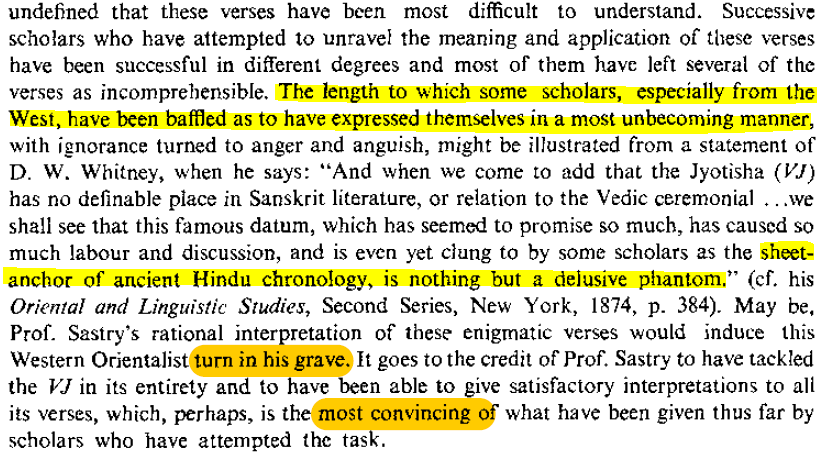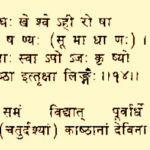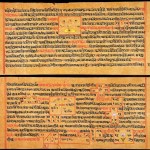The method of simply assuming results, once one is persuaded that they are true, rather than trying to prove them, has all the advantages of thievery over honest toil. - Bertrand Russell quoted in The Origins of Astronomy [5].
Introduction
This short article is a prequel to the ICP post on Vedanga Jyotisha (VJ). The prior post contains the answers to the questions from Indologists that are listed in this article.
https://indicportal.orgvedanga-jyotisha/
Epistemological Continuity
Scholars from within the Indic tradition successfully decoded the complex VJ text available in the form multiple rescensions, after 150 years of attempts by researchers from all over the world [1]. Their rigorous analyses, made possible by their multi-disciplinary expertise in Sanskrit, Jyotishastra, Ganita Sastra, and astronomy, have helped debunk many unsubstantiated claims regarding Indic sciences and VJ. Their research work can also enlighten contemporary eminent historians in India who remain unaware of the deep connection between science and Vedas. The findings about VJ clearly establish that its scientific innovations arise from Rta and Vedic Yagna, and its calendar recalls earlier Indic traditions [2]. The inter-connected developments in astronomy and other sciences also coincided with the growth of Ganita (‘science of computation’). This progress was part of an independent and continuous Indic tradition [5, 11] that spanned more than 3300 years, from the VJ and Sulba Sutras, to the genius of Madhava and Srinivasa Ramanujan. We have discussed Ganita Sastra and its epistemological continuity in this ICP post. Due to the integral unity [9] of dharma traditions, we also find this continuity in multiple other fields including Indic art, music, dance, etc.
Indologists Study Vedanga Jyotisha
The previous post concluded with three findings that are pertinent to this post:
- The date range for VJ (1150 – 1550 BCE).
- The location of VJ (Northern India / Kashmir).
- Necessary qualifications to study VJ in its original form [1]:
- a) Expertise in Sanskrit,
- b) knowledge of Western/modern astronomy, and
- c) an understanding of the concepts/practices of Hindu astronomy.
The absence of one or more of these three qualifications is likely to nullify the research effort and end in frustration [1].
Indology is a peculiar field. Sportspersons, scientists, and actors love their work, take pride in the history and traditions of their respective fields, and generally take their field forward. However, many career Indologists loathe the subject they study: Indic history and culture, and their research effort is directed toward producing results that can bring both down.
Summary of Claims
We reviewed the various assertions made by some (not all) western Indologists regarding VJ and ancient Indic astronomy and compiled a representative set of ten claims to discuss.
- The Vedic Indians possessed only a crude calendar.
- The Indics borrowed ‘Nakshatra’ from Mesopotamia.
- The Vedic calendar had no systematic intercalation.
- The date for VJ is 600 BCE or later.
- VJ content was created in Mesopotamia.
- Aryans brought astronomy and VJ ideas to India.
- Indian Astronomy was borrowed from Mesopotamia.
- The superiority of European time-keeping.
- The water clock is a Mesopotamian invention that Indics borrowed.
- Indic sciences exhibit a lack of originality, are repetitive, and non innovative.
Christopher Hitchens fans would say “what can be asserted without evidence can be dismissed without evidence“. On the other hand, these claims have been systematically studied and countered by multiple researchers, which allows one to dismiss them with evidence. For brevity, we have reviewed the arguments in [5], [3], and [1] to produce a limited response to each of these claims.
Claim 1
The Vedic Indians possessed only a crude calendar.
Response:
Many of the ideas in VJ are present in prior Vedic calendars. It is sophisticated for its time, and its mean measurements of lunar cycles and parameters, as well as the start time of the Yuga (a fundamental time unit of VJ), are remarkably accurate. The computations performed required expertise in modulo arithmetic, and the rule of three was employed as a subroutine. The invariant Nakshatra coordinate system, the Javadi table, the self-organizing and self-correcting Yuga based calendar, etc. indicate the depth of thought that the Vedic Indians put into the VJ. The Javadi table is a thing of beauty that emerges from Rta. We found hidden inside this table, a full-period linear congruential (pseudo random number) generator that enumerates the ecliptic longitudes of all the full and new moons in a Yuga. VJ combined observational astronomy and Ganita (computation). The resultant balancing of order and chaos is characteristic of the Indic method [9] that is anything but crude.
Summary: False claim that has to be rejected.
Claim 2
The ancient Indians borrowed Nakshatra from Mesopotamia.
Response:
The commonality of certain prominent Nakshatras across cultures is unsurprising since everyone shares the same sky. In particular, it has been shown that the importance of Krittika nakshatra (star group ‘Pleiades’) is special to not just one or two cultures, but to peoples across all continents [3]. The Vedic lists of Nakshatras start with Krittika and the Rta basis for this choice is that the seasonal year begins when the sun in this Nakshatra sector (in Vasanta ऋतु, spring season). Krittika is relatively easy to observe and is important for a variety of reasons tied to the seasonal cycles of agricultural planning, food gathering, etc., and not because one culture found it first and shared this ‘IP’ all over the world.
Nakshatras (as stars or star-groups) are fundamental to the Vedic calendar as summarized in the Vedanga Jyotisha post. On the other hand, the Nakshatra coordinate system of the VJ is a uniquely Indic development that is not found elsewhere. In VJ, the Nakshatras identify wide ecliptic sectors that yield an invariant ecliptic reference system, and not the stars themselves [3], as misunderstood by some western Indologists.
Summary: False claim that has to be rejected.
Claim 3
The Vedic calendar had no systematic intercalation
Response:
In our post, we summarized the findings of researchers on intercalation in VJ, and discussed the intercalary months (adhimasa or adhikamasa) employed by Vedic calendars, and how the VJ Yuga is a self-organizing system derived from Rta that contains built-in error-correction. VJ authors knew that the seasons must be synchronized with the sidereal year [3]. Such corrections prevented cascading errors (something that the European Julian calendar carried forward for more than a millennium until it was repaired for theological reasons by Catholic priests to safeguard the history-centrism [9] of their religion). The maximum error possible in the Vedic calendar has been calculated and shown to be bounded. Over the centuries, updated calendars and astronomical results were produced by the Indian astronomers and Ganita scholars.
The Indic method is systematic and is characterized by the Sanskrit non-translatable term abhiyukti (~algorithm) which is not entirely mechanical, but is comfortable with approximations, exceptions and non-mechanical corrections. This aspect can be seen continuously in Ganitasastra from the VJ to Aryabhata, from Madhava to Ramanujan.
Summary: False claim that has to be rejected.
Claim 4
VJ date is 600 BCE or later.
Response:
The astronomical time-stamp present in the VJ itself, a statistical analysis of the Nakshatra system, and other data enable us to narrow down VJ to a date range 1150-1550 BCE. It must be remembered that the VJ recalls earlier traditions that go further back in time. The 600 BCE or later date may have been proposed by Indologists so that it would be later than the earliest available Mesopotamian texts on astronomy (700 BCE), in order to satisfy their assumption of transmission from a Mesopotamian source.
Summary: This Claim has to be rejected. VJ dates several centuries prior, and is itself a culmination of results from previously existing traditions.
Claim 5
VJ content was created in Mesopotamia
Response:
Indologists latched on to the 3:2 ratio of the longest to the shortest day given in VJ to make this claim. This claim has been well-studied in [3]. The ratio depends on the latitude where these observations were made, and multiple locations qualify. However, most Mesopotamian areas are excluded, except for a couple of cultural centers in West Asia. Furthermore, a mathematical analysis reveals locations in the latitude range of 25N to 30N to be the more likely candidates, increasing the likelihood of an Indic origin, and significantly weakening claim 5. Furthermore, mention of this ratio shows up in Mesopotamian literature after 700 BCE, long after VJ’s latest possible date.
Summary: Unsubstantiated claim that has to be rejected. Kashmir is a likely candidate. Mesopotamian locations are unlikely.
Claim 6
Aryans brought astronomy and VJ ideas to India.
Response:
Aryan Invasion Theory (AIT), invented by Max Muller in the 19th century has been thoroughly debunked (historians have noted that the racist Aryan theory has been cynically exploited by two totalitarian regimes guilty of large-scale crimes against humanity: the British Raj and the Third Reich). There is no mention of such an invasion in Vedic text or Itihasa. Furthermore, the location and date of VJ, as well as its epistemology, considerably diminishes the chances of a non-Indic origin of VJ. There is a vast amount of work done by Indic scholars on this topic. The interested reader is referred to ‘Breaking India‘, by Rajiv Malhotra and Aravindan Neelakandan.
Summary: AIT today is a discredited theory, albeit one that has considerable propaganda value in contemporary Indian ‘vote bank’ politics, and thus the debate is unlikely to end soon. The only sure way to ‘prove’ AIT today is to assume that AIT is true and then find data (genetic models are popular in recent times) that agree with this assumption. Quite Easily Done.
Claim 7
Indian Astronomy was borrowed from Mesopotamia.
Response:
Again, the time period of VJ and prior Vedic calendars, and the secure epistemology of Indic astronomy, makes this a remote possibility. There are several differences between ancient Mesopotamian and Indic astronomy since the latter is rooted in Rta, which is Satya in action. For example: A seven-day week is recognized as a Babylonian artifact, and is not found in Vedic text. Note that a 7-day week is not clearly tied to Rta whereas ahoratra (day-and-night), Pakshas / lunar phases, and ऋतु (seasons) have naturally occurring periods that are observable (pratyaksha). They represent Rta, and are used within ancient Indic calendars. Per [3], the earliest mention of a seven day week in Indic literature is 484 CE, nearly two millennia after VJ. Research shows that the Hindus developed their own calendar and astronomy, and in many areas, were several centuries ahead of their time. (For example, see Ahargana in claim 8).
Summary: There was little need to borrow astronomical concepts from Mesopotamia or Greece since Indic astronomy was epistemologically secure [5] and advancing quite nicely. Ancient Indics had developed strong traditions in both algebra and geometry [5], a claim that few others (if any), can make. It may have been counter-productive to import alien concepts since it would require the Indics to force fit them into the Indic approach based on pramana, which is no easy task. In fact, a leading Indian scientist has argued that although this Indic policy of rejecting foreign paradigms (that lacked pramana) had positive outcomes, not re-working and adapting them into the dharma framework proved costly later.
Claim 8
The superiority of European time-keeping.
Response:
From the 18th century CE, European time-keeping and astronomy made rapid progress and took the lead. However, time-keeping there was not always as well developed. We can mention a couple of examples.
a) The Julian calendar (~45 BCE) produced a cascading error that could not be fixed until the Gregorian reform in 1582 CE. This effort relied at least partially on Indian time-keeping methods, using text from the Indian west coast obtained by visiting European missionaries during this time period. Once the Gregorian reform victory was secured for the church, Roberto De Nobili, the Italian Jesuit missionary in India (in 1610 CE) launched a diatribe against VJ to discredit the source text [11].
b) The Julian day number (not to be confused with the Julian calendar) was first created in Europe in 1583. This system calculates the elapsed time from a fixed date, Julian 1/1/4713 BCE. In comparison, Aryabhata’s Ahargana (‘heap of days’) method [5] for tracking elapsed time was already in use for a thousand years. Without a reliable method for time-reckoning, accurate time-stamping of historical events and record keeping is difficult.
Formidable numerical and calculating challenges had to be overcome by ancient cultures that did not yet possess Ganita. Commenting on the Indologists who ignored these epistemic gaps, Kosla Vepa [5] remarks:”[ancient Europeans] had no symbols or numbers larger than a thousand. Most Indians have been persuaded by the Colonial power into believing that Indian chronology is faulty and wanting (compared to whom?). Such an assumption is belied by the fact that it is the Indian records that they depended on to decipher what the Greeks did according to David Pingree. We will illustrate the inherent contradictions in their stance towards Indian historical record keeping in the chapter on knowledge transmission, where we examine a half a dozen instances of similar contradictions…”
Time-keeping (from small intra-day units to the largest time units) has been a part of Indian civilization for a long time, and evident in the earliest texts. The importance of history to Indic civilization cannot be understated.
https://indicportal.orgvedic-cosmology-the-dharmic-view-of-time/
Summary: The claim is rejected since the data suggests otherwise. It makes more sense to reverse the claim and find out whether the ancient Indic methods could be considered dominant based on the available data.
It would not be out of place to recognize the Indics as the original time-keepers of the cosmos.
Claim 9
The water clock is a Mesopotamian invention that Indics borrowed.
Response:
Indic water clock designs were different from the Mesopotamian ones. Ohashi’s informative paper (see [3]) on this topic debunks this claim and shows that post-Vedic water clocks were different from Mesopotamian ones. Furthermore, Narahari Achar [7] identified passages in Vedic text that suggest the usage of water clocks in Vedic times were also different in design.
Summary: This claim has to be rejected for lack of evidence.
Claim 10
Indic sciences exhibit a lack of originality, are repetitive, and non-innovative.
Response:
The VJ post shows that the exact opposite is true. This claim sounds childish now, after all the evidence meticulously uncovered by researchers, but such claims were taken seriously and parroted by multiple western Indologists in essays and books. There is a long list of Indologists who spent years learning from Sanskrit Pandits and thereafter U-turned and denied, diluted, or damned with faint praise, the original accomplishments of the ancient Indians, without pretence of objectivity.
Summary: It is time to reverse the gaze and study why, who, and from where the motivation for such sustained hostility to Indic civilization emerges from.

Many churlish claims were made by a researcher named David Pingree. It is worth studying his approach as a representative specimen of Euro-centric bias.
Who was David Pingree?
Professor Pingree was a mathematical historian at Brown University in the US, and much of his professional career involved the study of scientific material in ancient Sanskrit texts. After spending decades wading through Indic works to create his magnum opus, ‘a census (not just a sample) of the exact sciences in Sanskrit’, he opined that the Indics really did not come up with anything noteworthy and borrowed everything either from Europe (ancient Greeks), and if not Greeks, then from Mesopotamia. Interestingly, the volume of relevant manuscripts available from these ‘sources’ is minuscule compared to the massive amount of ‘borrowed’ material in Sanskrit that Pingree literally had to take a census of [5].
Pingree makes an implicit assumption that designates Indians as knowledge consumers and Greeks/Mesopotamians as knowledge producers. Thereafter, one can always speculate about how this transmission took place and find data that fits this assumption. Such Indologists would claim, without hard evidence, that many valuable results in Sanskrit texts were borrowed. If by chance, Indic priority was undeniable, then the claim would be that the G/M discovered it independently [5]. Pingree was neither the first, nor the last indologist to indulge in such narrative building exercises. The Aryan Invasion fiction is a necessary tool in this Eurocentric propaganda since it provides the Indologist a safe fall-back that ‘in any case, the Indic science and math came from the Aryan master race who invaded India’. The discussions in [5] and [3] thoroughly expose the methods employed by Pingree and other Euro-centric indologists.
It was an uphill task for Pingree to begin with as there are few, if any, primary sources of these claimed Greek results, and the earliest texts relevant to these claims belong to the Common Era [5]. As far as verifiable evidence of Greek-to-Sanskrit transmission to support these claims, there is none. However, in recent times, there is information regarding potential transmission in the reverse direction. In order to create a plausible picture from scant data, some Indologists have employed a technique called speculative reconstruction [5].
Some Indologists may have missed the lesson on 'etaddhasti darshana iva jatyandhah'. Different people can look at the same data and arrive at entirely different conclusions that suits their preconceptions.
Speculative Reconstruction
A grand narrative promoted by Euro-centric Indologists requires a glorious, ancient Greek past where almost everything important in science and math today originated there (or independently discovered there, if someone else got lucky and did it first). Researchers like Pingree have devoted entire careers, producing results that further this goal. They have succeeded spectacularly, if one looks at all the theorems, results, and entire areas in mathematics that are attributed to Europeans in textbooks, starting from the Pythagoras theorem and Euclidean geometry to Fibonacci series to Newton’s calculus and McLaurin/Taylor series. It is as if no worthwhile mathematics ever happened outside the Judeo-Christian domain (!). These historians of math have often employed speculative reconstruction (SR) to guess the original result from partial data. SR combines imagination with contemporary math to form a conjecture about what was done thousands of years ago.
Recently, researchers have used such methods to try and push back the date of trigonometry in ancient Mesopotamia by creatively reinterpreting an ancient manuscript: Plimpton 322. Other western experts saw through this as a marketing exercise. A key counter-argument to such claims is that exceptional “3000 years ahead of xyz” events is unlikely to occur in a vacuum. Showing the continuity in epistemology throughout that time period, and establishing a historical context for the result goes a long way in making such claims credible and reduces the chances of being dimissed as hype.
SR in itself may be a useful academic tool, but its value as confirming historical evidence is nil since it is speculation. Some Indologists have employed multiple layers in SR, i.e., they have rejected part of the historical data as mistakes committed by the author thousands of years ago and then generated new data ‘to correct the error’ and essentially produce what they assumed. An outrageous example is the ‘chord table of Hipparchus‘ where SR was used to claim that Aryabhata borrowed his R-sine difference table from this [5]. This claim has been exposed by Indic researchers by showing how SR works and then explaining the original Ganita in Aryabhatiya and its commentaries.
Final Note
Of all the subjects we studied in school, Mathematics was regarded as the least subjective. As a historian of mathematics in a top US university, why did Pingree adopt such an utterly biased approach when it came to Indology? To understand his motivation, let us turn to his PhD work. One of his graduate advisors was Daniel Ingalls.
Ingalls visited India and learned Sanskrit, became a celebrated professor of Sanskrit in the US, and authored several works on Sanskrit literature. The names of the students who did their PhD work under Ingalls read like the who’s who of Hinduphobic Indologists: Wendy Doniger, Sheldon Pollock, John Stratton Hawley, and others. Daniel Ingalls has received relatively limited attention from Indic scholars so far, since the spotlight has been grabbed by the infamous bunch of students he spawned . He served as an espionage agent during WW2, when he was required to spy on Indians in Kabul. His closest Indian friend was the Marxist DD Kosambi. His student, Padma Shri Sheldon Pollock, has progressed further and is the darling of both Indian marxists and Islamic fundamentalists. Indian billionaire Narayana Murthy’s son Rohan Murty, provided more than USD 5M to fund his subversive work. More than 50 students got their PhD under Ingalls and teach in major universities. The co-authors of the Harvard tribute to Ingalls that we have excerpted here includes Diana Eck and Micheal Witzel, well-known for their Hinduphobic writings.
Ingalls’ life-story deserves to be thoroughly researched since he succeeded in learning Sanskrit from the Pandits in India, and eventually produced an army of Sanskrit-aware western-supremacist scholars who, until recently, have hijacked and poisoned the discourse in India, and have been rewarded by the Indian government, media, and industrialists for this effort.
Juan Pujol Garcia (codenamed Garbo) was a spy and a dedicated double agent against the Nazis in WW2. His contribution toward the allied D-day deception is considered critical. He received major military awards from the Nazis and the British.The Germans paid for his fictional network of 27 Nazi spies. Once, one of these spies was killed, and the Nazis generously paid out a pension to his equally fictional widow. By the end of the war, German intelligence was actually funding British intelligence, paying several hundred thousand USD.
References
- KV Sarma and Kuppanna Sastry. Vedanga Jyotisa of Lagadha In its Rk and Yajus Rescensions. With the Translation and Notes of Prof. T. S. Kuppanna Sastry. Critically edited by K. V. Sarma. Indian National Science Academy. 1985.
- Subhash Kak. Astronomy and its Role in Vedic Culture. Chapter 23 in Science and Civilization in India, Vol. 1. The Dawn of Indian Civilization, Part 1, edited by G.C. Pande. ICPR/Munshiram Manoharlal, Delhi, 2000.
- Prabhakar Gondhalekar. The Timekeepers of the Vedas: History of the Calendar of the Vedic Period (From Rgveda to Vedanga Jyotisa). Manohar Publishers. 2013.
- K. Ramasubramanian. Perspectives on Indian Astronomical Tradition. HH Dalai Lama Premises. Dharmasala. 2016.
- Kosla Vepa. The Origins of Astronomy, the Calendar, and Time. Lulu.com. 2011.
- Narahari Achar. Enigma of the Five Year Yuga of the Vedanga Jyotisa. Indian Journal of the History of Science (33). 1998.
- Narahari Achar. A Case for Revising the Date of Vedanga Jyotisa. Indian Journal of the History of Science (35). 2000.
- John Playfair. The Works of John Playfair (Vol. 3).. with a memoir of the author. Edinburgh, A. Constable & Co. 1822.
- Rajiv Malhotra. Being Different: India’s Challenge to Western Universalism. Harper Collins. 2011.
- Sudha Bhujle and MN Vahia. Possible Period of the Design of Nakshatras and Abhijit. Annals of the Bhandarkar Oriental Research Institute. 2006.
- C. K. Raju. The Cultural Foundations of Mathematics: The Nature of Mathematical Proof and the Transmission of the Calculus from India to Europe in the 16 c. CE. Pearson Education. 2007.
- Subhash Kak. The Astronomical Code of the Rig Veda. Oklahoma State University, Stillwater. 2011.
- Subhash Kak. The Wishing Tree: Presence and Promise of India. iUniverse Inc. 2008.
- Kapila Vatsyayan. The Square and The Circle of The Indian Arts. Abhinav Publications. 1997.
- R. N. Iyengar. A Profile of Indian Astronomy before the Siddhāntic Period. ISERVE Conference, Hyderabad, India. 2007.
- Kuppanna Sastry. The Main Characteristics of Hindu Astronomy in the Period Corresponding to Pre-Copernican European Astronomy. Indian Journal of the History of Science (Vol 9). 1974.
Acknowledgments
Thanks to N.r.i.pathi garu for his patience and encouragement.




